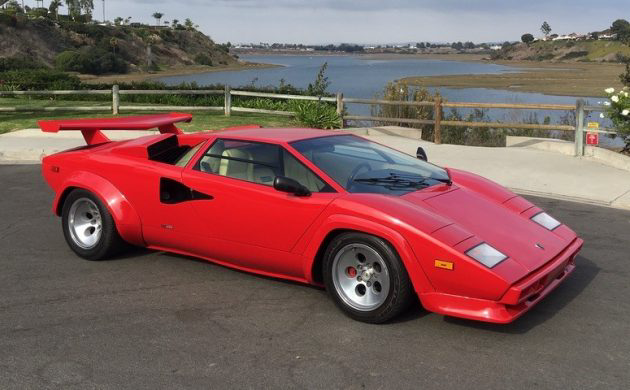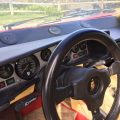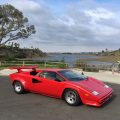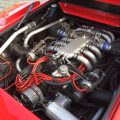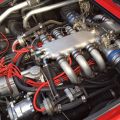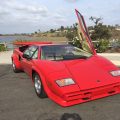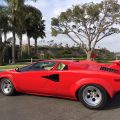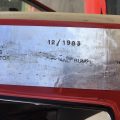Asking Price: $299,000
Location: Costa Mesa, CA
Mileage: 18,000
Title Status: Clean
Seller’s Description: Having already made its mark in less than a decade of existence with sophisticated GT models and the world’s first Supercar, the Miura, Automobili Lamborghini shocked the motoring world with the stunning new Countach at the 1971 Geneva Motor Show. Named after a loosely translated and rather risqué Piedmontese expression of utter disbelief, the otherworldly Countach remains outrageous even by today’s jaded standards. Styling was a masterwork by renowned Bertone stylist Marcello Gandini and drew inspiration from his earlier Alfa Romeo Carabo show car of 1968 and the futuristic Bertone Zero concept of 1970. Angular, extremely low, and decidedly futuristic, the trademark scissor doors, menacing presence, and blinding speed of the Countach defined it throughout production and continue to leave all who experience it speechless today.
The production Countach, designated LP400 in recognition of its somewhat downsized yet potent 4.0-litre V-12 powerplant, debuted at Geneva in 1973. While closely resembling the LP500 prototype, the LP400 was updated at the insistence of Lamborghini development driver and engineer Bob Wallace, with the Marchesi-built chassis redesigned and the body now constructed of lightweight aluminum. Further weight savings were achieved with special glass procured from Belgium’s Glaverbel and a switch to magnesium for some mechanical components. Cooling was enhanced on production cars with additional air boxes feeding relocated radiators, along with efficient NACA air ducts added to the bodysides. To aid rearward vision, a periscope-type, over-the-roof viewing device led to the unofficial “Periscopo” moniker of the LP400.
After 157 LP400s were built, the comprehensively updated LP400S arrived at the 1978 Geneva Motor Show. Created at the insistence of increasingly prominent Formula 1 team owner and Lamborghini enthusiast Walter Wolf, the LP400S was Lamborghini’s initial counterattack to the rising threat posed by Ferrari’s 512 Berlinetta Boxer. In addition to ultra-wide wheels and Pirelli’s new P7 ultra-performance tires delivering immense grip, the LP400S featured redesigned underpinnings including new 4-piston disc brakes and numerous detail refinements. Aggressive fiberglass fender flares housed the new rolling stock and influenced Countach design throughout the remainder of LP400S production, with 237 made along three distinct series through 1982.
Despite the many improvements applied to the LP400S, increased aerodynamic drag and emissions compliance in certain markets hampered top-end performance somewhat. Famed Italian engineer Giulio Alfieri came to the rescue, massaging the Countach into the LP500S, also badged as the LP5000S. Lamborghini’s famed V-12 engine was upsized to 4.8 liters and still rated 375 BHP, with a bore and stroke increase compensating for a slightly lowered compression ratio. Larger Weber carburetors and carefully selected gear ratios maximized performance. Acceleration from rest to 60 mph now required just 4.8 seconds and top speeds ranging from 150 – 175 mph were quoted in various sources, depending upon road length and driver skill. As with all prior Countach iterations, the LP5000S debuted at Geneva; 321 were produced between 1982 and 1985.
This particular Lamborghini Countach completed its build on 12/1983. One of the 321 units built between March of 1982 and March of 1985. Considered the 3rd generation with the redesigned 4.8 liter engine and new model designation 5000S. The supercar beginning for the U.S. with the low roofline and horizontally hinged doors it may be the most recognized supercar design and universally appealing. The Steele tubular space frame by Marclesi with aluminum panels and fiberglass wheel arc extenders bring the Marcello Gandini design of Bertone to production with a U.S. sticker price of $102,000.00.
This Countach is one of the early cars to meet U.S. requirements with the 2V and Bosh K-Jettronic fuel injection system for North America before the 4V fuel-injected cars were built. This injector is a plain design no names or structural ridges in the top of it, just smooth as on chassis 12507 the fuel injection prototype example. The odometer is in kilometers for recording distance and shows both K.P.H. and M.P.H. for speed, see the picture now showing 33,736 Kilometers the equivalent of 20,962 miles.
The door sticker states “conforms to applicable U.S.” along with the bumper safety statement all on the factory Lamborghini tag. The paint and interior of the car show nicely with a powerful sounding motor and detailed overall presentation. Argued as few as 12 and as many 37 of these early 2V fuel-injected cars were manufactured for the beginning of the North American Supercar market with limited availability and enthusiasm that continues today.
Stella
List your classified here on Barn Finds!
